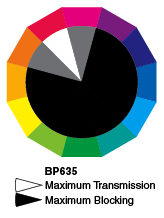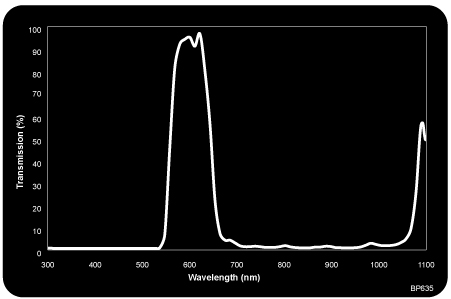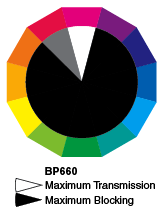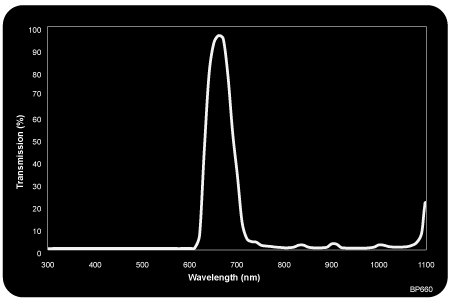|
|
Colour Bandpass Filters
These filters allow you to control, selectively, what your camera sees
and are ideal for LED or laser diode use. Far more rugged, thinner, less
angle-sensitive, with much higher transmission and far lower in cost compared
to conventional interference filters, they greatly improve contrast and
eliminate the need for a costly light shroud.
| Blue bandpass
filter - blue LEDs/UV fluorescence |
|
Model |
Transmission |
Features
and effects |
Suitable
for |
|
|
BP470 |
420-500nm |
• Enhances blue lighting and fluorescence
• Passes
only blue light sources / UV-excited blue fluorescence without autofluorescing
itself
• Tests the effects of blue lighting on an application
• Improves resolution by focusing only blue wavelength |
Use
with 470nm blue LEDs and for UV fluorescence imaging |
|  
BP470 filters are recommended for use in most blue LED (~470nm)
and many UV-excited blue fluorescence (430-500nm) imaging applications.
Important for both applications is the breadth of the bandwidth.
In the case of blue LEDs, frequent variations in center wavelengths
and angles of incidence can easily be accommodated. BP470 ABSORBS
lower wavelengths (e.g., UV) and REFLECTS longer wavelengths (e.g.,
500-1150nm). This material does not auto-fluoresce.
For typically weak blue fluorescence applications, it is important
to be able to detect as much of the blue emission as possible while
effectively blocking all of the UV light. Since more than 90% of
all industrial UV fluorescence applications involve imaging a blue-colored
“glow,” it can be summarized that most applications
involving a UV light REQUIRE the use of a BP470 filter. Without
this filter, it is virtually impossible to successfully image the
desired feature.
The BP470 blue bandpass filter is recommended
over all other blue filters because of its broad peak (T>90%),
high transmission, far superior blocking of shorter UV and longer
IR wavelengths, and far steeper cut-on and cut-off slopes. All of
this results in far brighter, higher contrast images when using
the BP470 compared to other filters currently available.
These single substrate, hard-coated filters are about 2mm thick
and can withstand very high temperatures. The coatings are just
as or MORE durable than the glass. Therefore the limiting factor
is the transformation temperature and thermal gradient/shock values
for the glass.
|
| Cyan
bandpass filter - Recommended for use with cyan LEDs |
|
Model |
Transmission |
Features
and Effects |
Suitable
for
|
|
BP505 |
475-565nm |
• Absorbs UV and deep blue
• Reflects 570-1100nm
• Produces images that are especially bright and very high
in contrast
|
505nm LED lighting |
|  
The BP505 filter was designed for use with 500-510nm cyan LED lighting.
It also has a function in UV fluorescence imaging of some commonly
used stains.
The BP505 single substrate, hard-coated filter is designed to match
the output of most cyan LEDs, widely considered to currently be
the brightest "monochrome" LEDs available. Coupled with
the spectral sensitivity of most CCD/CMOS sensors in use today that
also peak in this range, this filter will result in images that
are especially bright and very high in contrast.
The BP505 filter is particularly designed for use in line-scan/wide
angle applications where they are extremely resistant to the effects
of "blue shifting." Used together with the right lensing,
a line of uniform end-to-end brightness can be imaged at wide angles.
|
| Light
green bandpass filter - Recommended for use with green LEDs/fluorescence |
|
Model |
Transmission |
Features
and Effects |
Suitable
for
|
|
BP525 |
495-565nm |
• Absorbs UV and blue
• Reflects 570-1100nm |
Green LEDs/fluorescence imaging |
|   BP525
filters have been designed for use in almost all green LED or laser
diode applications. These single substrate, hard-coated filters
also have wide application in UV fluorescence imaging of various
commonly used stains and plastic materials that fluoresce in the
green portion of the spectrum. BP525
filters have been designed for use in almost all green LED or laser
diode applications. These single substrate, hard-coated filters
also have wide application in UV fluorescence imaging of various
commonly used stains and plastic materials that fluoresce in the
green portion of the spectrum.
We strongly recommends the BP525 s because of its broad passband,
far higher peak transmission, superior blocking of UV and IR wavelengths,
and reduced sensitivity to angle of incidence changes.
The BP525 will nearly always result in significantly brighter and
higher contrast images.

(left) Monochrome image
with white light.
(center) Commonly used photographic filter doesn't help at all.
(right) The BP525 clearly brings out the details and improves
subject recognition.
|
| Orange
bandpass filter - Recommended for use with amber/orange LEDs/UV fluorescence |
|
Model |
Transmission |
Features
and Effects |
Suitable
for
|
|
BP590 |
555-615nm |
• Absorbs 200-550nm
• Reflects 620-1090nm |
Amber/orange LEDs and fluorescence imaging |
|   BP590
single substrate, hard-coated filters are recommended for use in
systems that use amber or orange LED lighting. They are also very
widely used in fluorescence imaging applications, particularly with
certain inks and ethidium bromide, Qdot 605 and other similar stains. BP590
single substrate, hard-coated filters are recommended for use in
systems that use amber or orange LED lighting. They are also very
widely used in fluorescence imaging applications, particularly with
certain inks and ethidium bromide, Qdot 605 and other similar stains.
Peak transmission is greater than 90%. Blocking of shorter AND
longer wavelengths averages >99% when used in conjunction with
any sensor that has a typical silicon response. This is particularly
important in situations where infrared light may be present. Orange
longpass filters have traditionally been recommended for these applications,
but they offer no such IR blocking and therefore contrast can suffer.
|
| Light
red bandpass filter - Recommended for use with red laser diodes and
LEDs |
|
Model |
Transmission |
Features
and Effects |
Suitable
for
|
|
BP635 |
600-660nm |
• Absorbs 200-590nm
• Reflects 670-1080nm |
Red laser diodes and LEDs |
|   Recommended
for 610-650nm LED and laser diode lighting. Because of its broad
bandwidth and high peak transmission, the single substrate, hard-coated
BP635 works very well for all lighting applications in this range. Recommended
for 610-650nm LED and laser diode lighting. Because of its broad
bandwidth and high peak transmission, the single substrate, hard-coated
BP635 works very well for all lighting applications in this range.
Coloured longpass filters have long been recommended for use with
monochrome cameras to aid in increased contrast and resolution.
These filters block UV and shorter visible wavelengths, and pass
longer wavelengths of light. Except in those few cases where an
IR blocking or other shortpass filter is incorporated into the camera
or sensor, We will often recommend the use of a broad color bandpass
filter (whose designs incorporate these longpass filters) over color
longpass filters alone.
|
| Dark red bandpass filter - Recommended
for use with darker red LEDs and structured laser diodes |
|
Model |
Transmission |
Features
and Effects |
Suitable
for
|
|
BP660 |
635-690nm |
• Absorbs 200-630nm
• Reflects 695-1100nm |
650-680nm darker red LEDs and structured
laser diodes |
|   Because of its ample bandwidth and excellent in-band transmission,
it works very well for all camera-related applications in this range
and is a popular product.
Because of its ample bandwidth and excellent in-band transmission,
it works very well for all camera-related applications in this range
and is a popular product.
Colour longpass filters, sometimes referred to as "sharp cut"
filters, are often suggested by others for creating increased contrast
and resolution. They will block UV and shorter visible wavelengths
but still pass all longer wavelengths. Except in those few cases
where an IR-blocking or other shortpass filter is incorporated into
the camera or sensor, we will, for the most part, recommend the
use of one of the broad colour bandpass filters (such as the BP660)
over these "sharp cut" longpass filters alone. The results
are consistently improved contrast in most inspection applications
over the long term.
|
 Back to Top
Back to Top 
| Model |
Model # |
| Dimensions |
4.5" x 5.0" x 2.5" |
|










 BP525
filters have been designed for use in almost all green LED or laser
diode applications. These single substrate, hard-coated filters
also have wide application in UV fluorescence imaging of various
commonly used stains and plastic materials that fluoresce in the
green portion of the spectrum.
BP525
filters have been designed for use in almost all green LED or laser
diode applications. These single substrate, hard-coated filters
also have wide application in UV fluorescence imaging of various
commonly used stains and plastic materials that fluoresce in the
green portion of the spectrum. 

 BP590
single substrate, hard-coated filters are recommended for use in
systems that use amber or orange LED lighting. They are also very
widely used in fluorescence imaging applications, particularly with
certain inks and ethidium bromide, Qdot 605 and other similar stains.
BP590
single substrate, hard-coated filters are recommended for use in
systems that use amber or orange LED lighting. They are also very
widely used in fluorescence imaging applications, particularly with
certain inks and ethidium bromide, Qdot 605 and other similar stains.

 Recommended
for 610-650nm LED and laser diode lighting. Because of its broad
bandwidth and high peak transmission, the single substrate, hard-coated
BP635 works very well for all lighting applications in this range.
Recommended
for 610-650nm LED and laser diode lighting. Because of its broad
bandwidth and high peak transmission, the single substrate, hard-coated
BP635 works very well for all lighting applications in this range.

 Because of its ample bandwidth and excellent in-band transmission,
it works very well for all camera-related applications in this range
and is a popular product.
Because of its ample bandwidth and excellent in-band transmission,
it works very well for all camera-related applications in this range
and is a popular product.